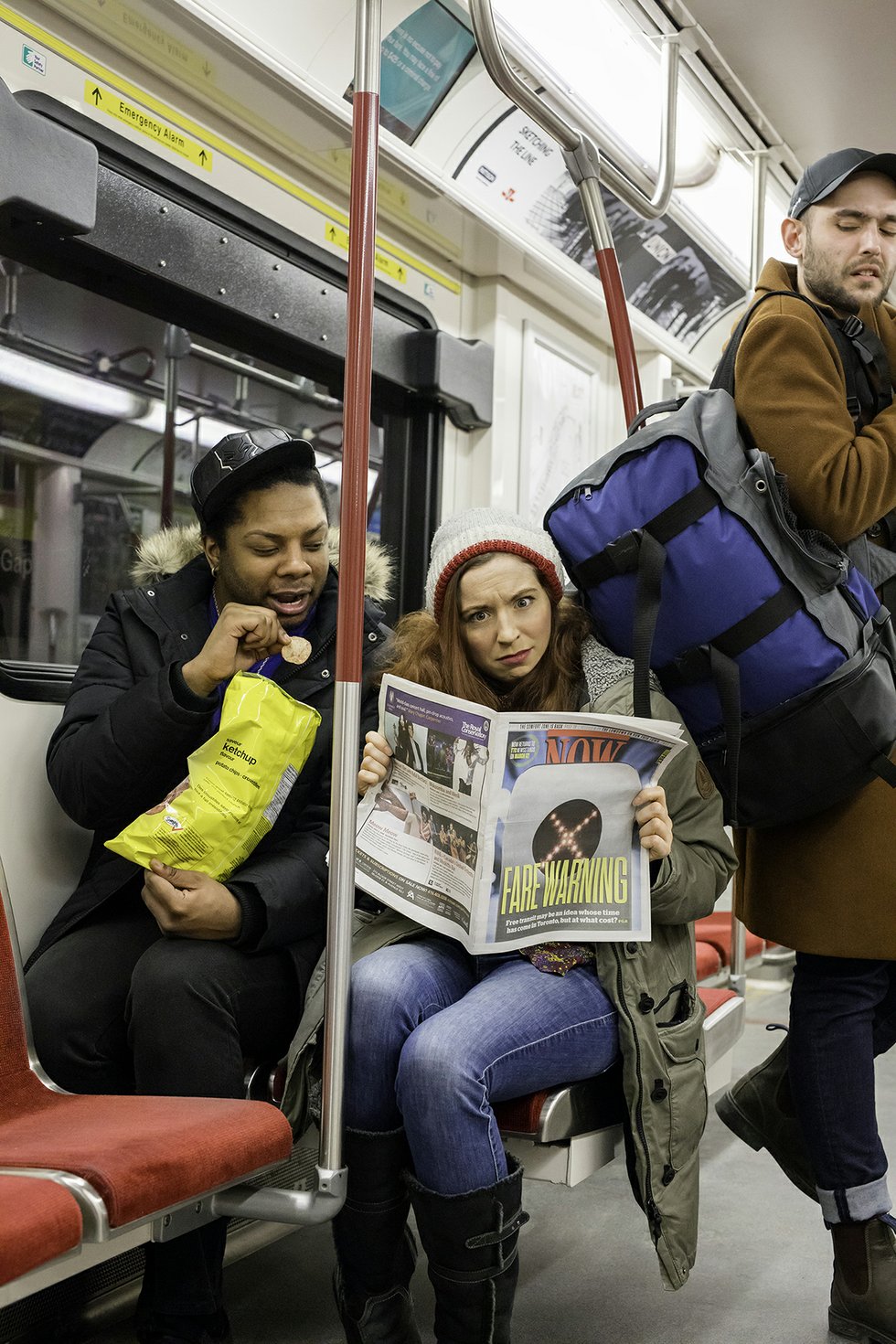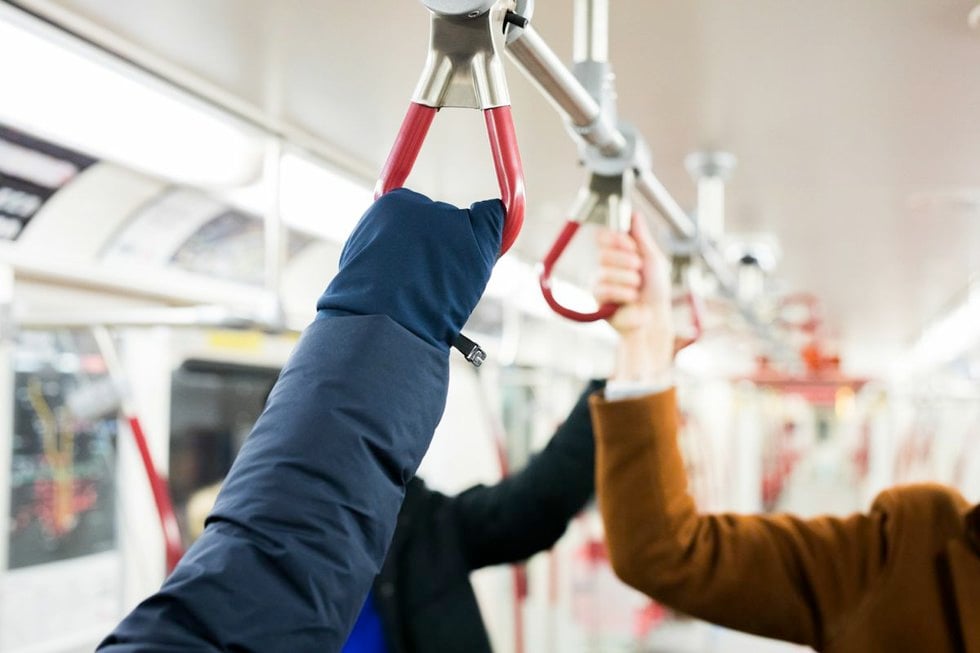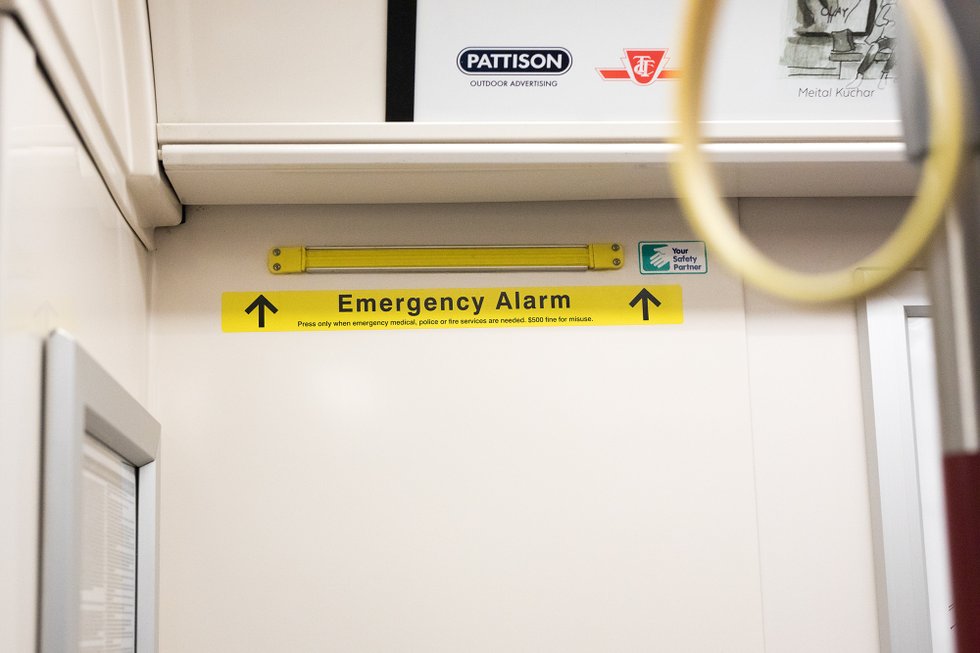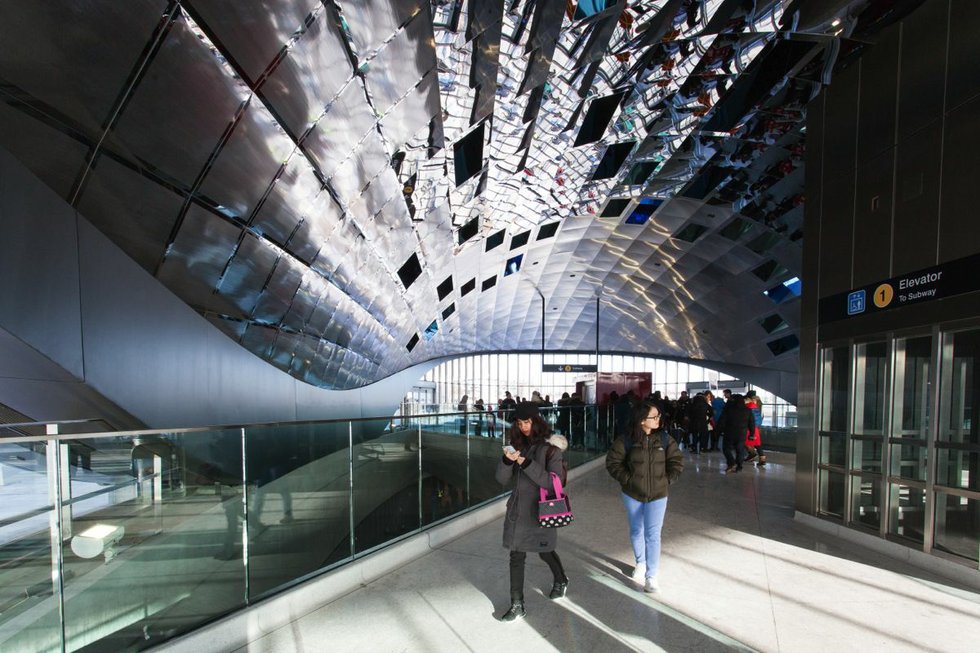
As Toronto emerges from a winter of transit discontent – almost-daily delays, packed platforms, draconian fare evasion enforcement, broken Presto machines – TTC riders are looking forward to literal sunnier days (at the very least).
But there’s at least one thing that will make riding the TTC more fun this spring: NOW Magazine has returned to Gateway newsstands in the subway, as well as at GO Transit stations.
To mark the occasion, we’ve compiled travel tips, rules of etiquette and hidden secrets to help riders get from point A to point B with a little less stress (and a little more fun).
ETIQUETTE
Is it okay to rest my feet on a bus or subway seat?
A general rule of thumb to remember when it comes to public transit: This isn’t your home. However, in a Twitter poll, 69.8 per cent of NOW’s followers said no to feet on seats – while 27.1 per cent say if no one’s around, you’ve got a bit of a loophole. When in doubt, just remember: Would you want to stand up and walk off the train with a dirty footprint on your backside?
Can (or should) I talk on the phone on the subway?
Freedom Mobile customers are able to access wireless services underground on the TTC, and there is free WiFi service available at all stations.
Is it rude to talk on the phone on the TTC? We asked NOW readers on Twitter: 69.7 per cent of respondents said “Yes – just keep it down,” and 30.3 per cent said “No.” Just keep in mind that everyone around you can hear every word you say.

Samuel Engelking
Can you eat on the TTC?
There’s nothing quite like eating a Caesar salad on a hot summer’s day – during rush-hour traffic on the streetcar. Or licking the Cheetos dust off your fingers, one by one, before clasping a subway pole. While countries with clean and orderly public transit systems ban food to minimize trash, Toronto has not banned the practice.
There are valid reasons to eat or drink on the TTC – for medical reasons, to stay hydrated or because a home with a roof and dining table are not as accessible to you as a streetcar. When Toronto tried to ban food and drink on transit in the 80s, the Ontario Municipal Board quashed the move after a diabetic rider fought back.
Public opinion is somewhat divided. A poll of NOW’s Twitter followers found 58.2 per cent say non-smelly snacks are okay, 27 per cent have no issues with anything you’re eating, and 14.8 per cent think you should never eat on the TTC.
If you need to eat, here are a few ways to be courteous to fellow passengers:
• Clean up after yourself and don’t litter.
• Stay contained. Don’t eat things that require utensils, dips, sauces or other garnishes.
• Eat quietly. Chips are probably pushing it, but if you have a knack for chewing quietly, the bus is your oyster. (Also: don’t eat oysters on the bus.)
• Remember: If you can smell it, so can everyone else.

Getty Images
Can I put on makeup or do my hair?
As long as it’s not super messy and there aren’t elbows flying, that’s fine. But never, ever should you trim or file your nails. And if you think the rogue nail clipper is just an urban legend, according to our Twitter poll, 57 per cent of respondents have witnessed someone in the act.
What’s the etiquette around talking to strangers?
No matter what time of day or how busy, there’s always a Chatty Charlie on board. That said, you have no responsibility to engage with them.
Plenty of meet-cutes take place on the subway, but be respectful. You could try to make eye contact or, for example, bond over what the person might be reading. But pay attention to social cues if someone ignores you or gets up and moves, they’re likely not in the mood. If someone strikes up a convo and you’re not interested, an option is to say that you’re tired and would like to rest your eyes – or, yes, move elsewhere.
It’s worth noting, however, that a 2014 study by University of Chicago Booth School of Business found those who do interact with strangers on transit have more positive commuting experiences than those who choose to “sit in solitude.” In fact, if you have the patience, it can be an antidote to an otherwise bad day.

Samuel Engelking
What’s the etiquette around backpacks?
Unless the streetcar/bus/subway is so empty you can sashay through without coming within two feet of another human, take off your backpack. When seated, keep it planted on your lap. When standing, hold it low by your legs so you’re not taking up body-space by clutching it at chest level. (Only if there are multiple vacant spots available should you put your wares on another seat.) And if you’d like to sit somewhere currently occupied by an inanimate object, it’s completely acceptable to politely ask the seat hog, “Excuse me, do you mind moving your bag?”

Getty Images
Can I wear rollerblades on the TTC?
In-line skates and skateboards are strictly prohibited on TTC property. So you’ll have to tote around a pair of shoes if you want to take your enthusiasm for in-line skating on transit.
TRAVEL TIPS

Samuel Engelking
What should I know about using Presto?
In recent months, many riders have found the TTC’s fare-evasion campaign to be hostile – an unpopular move made more controversial by miscommunication over fare policy, a frequently malfunctioning PRESTO system, a fare hike and reports of inspectors violently handling riders.
Frustrations came to a head when many began sharing their confusion on social media over the two-hour transfer window, and whether you can be fined if you are still riding on a TTC vehicle after the window has expired – even if you tapped on for your latest ride during the window.
In response, the TTC’s official Twitter account issued a misleading correction and later clarified the error, which suggested that even TTC representatives are unclear on the policy, and have potentially falsely fined riders.
To clarify: Riders can tap as many times as they like within a two-hour window. Even if you’re still on a streetcar, for example, and the two hours have passed but your last tap was before the end of the window, you won’t face an additional charge.
Inspectors should be able to note your tap history and whether there is money or a pass on your card. And if you’re faced with a malfunctioning machine, you can tap or pay at the next transfer point.
In the meantime, new card-reader screens are set to be rolled out by the end of the year, and will display details such as money left on a pass and the time left in a transfer window. The PRESTO app, too, will become more functional for Apple users, who will be able to instantly load funds via their phones. The TTC is also reviewing its child pass policy, after a study found they are often being used fraudulently.
READ MORE: How the TTC and PRESTO are dealing with rider criticism
Where are the bathrooms?
There’s nothing worse than waddling off the train and making a beeline for the bathroom only to find that there isn’t one at the station. Or, if there is, the locks don’t work, the floor’s wet and there’s no TP.
Such is the TTC bathroom-scape. First, here’s which few stations actually have them. On Line 1: Vaughan, Sheppard West, Wilson, Bloor/Yonge, Eglinton, Sheppard-Yonge, Finch on Line 2: Kennedy, Warden, Kipling and on Line 4: Don Mills.
The grossest offenders have been consistent over the last decade: Kennedy, Kipling and Finch – largely for their very specific smell, humid air and frequency of human waste not actually making it into the toilet bowl.
It’s always advisable to hit the bathroom before you start your commute, but the urge can hit when you least expect it. If you’re willing to just make a break for it and pop out of the subway station entirely, a useful resource is the GoHere Washroom Locator app, created by Crohn’s and Colitis Canada.
In the end, it really depends on just how badly you have to go. Because when it’s urgent, a broken toilet seat and urine-soaked floor can’t stop even the best of us.
My train/bus/streetcar is late. What can I do?
Download a TTC tracker app so you can monitor just how delayed your ride is knowing how long you have to wait can ease a whole lot of stress. If you don’t have an app, you can text the code posted on your stop’s pole to the TTC text service (898882) to find out how far away your bus or streetcar is. If it’s still a lengthy (or unknown) delay, you can tweet at @TTChelps, or consider other routes by checking the station map or your own GPS.
If it’s not too far a distance, walk it if it is, cab it. If those aren’t options, there’s unfortunately not much else to do but wait it out and focus on the fact that the sky is blue, the grass is green and the TTC runs late. Before you head out on your commute, it’s also worth checking @TTCnotices in case of any service alerts so you can plan ahead.
What are the best TTC apps?
No tool is more useful when navigating the TTC than a solid app, especially when delays are frequent. Most transit apps use the same real-time GPS data, so what it really comes down to is interface and details. With all of the following apps, you get up-to-the-minute predictions, detailed maps, stop points and service alerts: TTC Watch, Transit Now, Transit, Rocketman and Moovit.
The last three include trip planners, Transit Now features subway station maps and TTC Watch allows you to pin multiple routes. The one simply called Transit, however, may just have the sleekest, cleanest interface – and being able to use it in most other cities is pretty handy.

Samuel Engelking
How do I navigate a crowded bus, subway train or streetcar?
If you’re riding the TTC at rush hour, consider yourself lucky if you’ve managed to find a seat. (If you’re getting off soon, grab one close to the door so you aren’t threading your way through the crowd to exit.) But if not, and you do not possess excellent balance, stay as close as possible to a pole or overhead strap. Rest your bag by your side or by your feet, and try not to let your arms and hands wander. And use your words: if you’ve got to get to the door or would like to move, offer an “excuse me.” Commuters are more likely to move aside for manners than a shove or an awkward graze.
What are the most – and least – accessible TTC stations?
The TTC has an obligation to become fully accessible by 2025. Though many steps have been taken toward this goal, there’s still a long way to go: Currently, only 46 of the system’s 75 stations are accessible.
First, the worst: Warden Station has stairs scattered throughout the main part of the station. The nine bus platforms are accessed only by venturing down two flights of stairs, and each platform is entirely separate from one another. There are no elevators, and the only escalators are from the concourse to train platforms. Elsewhere, although there are elevators servicing the Bloor-Danforth portion of Spadina station, accessing the Yonge-University line is an absolute nightmare. The entrance to Line 1 has three flights of stairs, though the trains can be accessed from the Line 2 entrance after travelling through a long, dark tunnel.
As for the better stations: Dundas West houses a McDonald’s on street level, as well as nearby connections to GO Transit and UP Express. Two bus routes and two streetcars can be accessed at street level inside the station, and there are benches within the seating area, as well as elevator access to the trains.
Bathurst Station’s central location makes it quite convenient. Just past the turnstiles is an elevator to access the concourse, complete with a sandwich shop and bakery, as well as trains. At street level, there is a northbound bus and a southbound streetcar that goes to Exhibition Place.
What’s the deal with Wheel-Trans?
Wheel-Trans is a TTC specialized service that provides door-to-door shuttles for riders who face accessibility barriers to using buses, streetcars or subways. The system has long been a sticking point for many disabled travellers, who frequently deal with late pickups or no-shows. (The TTC has claimed that that 89.6 per cent of Wheel-Trans vehicles show up within ten minutes of the schedule, though that figure is not consistent with the general consensus amongst the disabled community.)
At the tail end of 2019, changes to the system created additional barriers for many of its users. An estimated 25,000 users will be undergoing reassessment to gauge their eligibility for the program, which could take years. The disability community has pushed back against this decision, seeing it as a gatekeeping process that will decide exactly who is “disabled enough” to have full access to this service. Now, Wheel-Trans users with permanent disabilities fear they will lose the door-to-door service.
The TTC has updated the Wheel-Trans booking process so riders are able to book same-day “family of service” rides, which utilize a mixture of Wheel-Trans vehicles and the typical transit system, with four hours’ notice. But riders who are “unconditional” users, who require door-to-door transit, usually have to plan their trip 24 hours in advance – which obviously doesn’t offer customers the same flexibility enjoyed by other transit riders.
Riders are also at risk of losing access to Wheel-Trans if they are a no-show themselves or require too many “late” cancellations, which is cancelling after 11 pm the day before the trip.
If you’d like to get into the Wheel-Trans system, you must apply by completing a form with your doctor. Once you’re registered, you can book a Wheel-Trans trip at mywheel-trans.ttc.ca, using the automated RideLine phone service, or by calling 416-393-4222 (though if you call here, be prepared for a lengthy queue). If your vehicle is a no-show or your vehicle is late by 30 minute or more, call the Priority Line at 416-393-4311.

Natalia Manzocco
Where can I charge my phone in the TTC?
Many TTC subway stations have electrical outlets along the platform and in walkways, hidden behind protective metal covers. (The one above, decorated with some very handy graffiti, can be found in Spadina station.) Just be sure to find a spot out of the way of pedestrian traffic to stand.
Additionally, the TTC’s fleet of electric buses (if you’re lucky to spot one out in the wild) are outfitted with USB chargers in the poles. An easy way to tell if the bus that just pulled up has chargers is to look over the door at the bus number: If it’s an electric bus, the number will start with a three.
How do I get WiFi in the TTC?
Every TTC station is outfitted with WiFi. Just select TCONNECT network for the ad-supported service. The WiFi works at street level and on the subway platform, which is where you should open as many browsers and apps as you can, load up on all the pages you want to read because the signal is lost as soon as you’re in a subway tunnel between stations. (Also, NOW is back at Gateway Newsstands, so grab a copy before boarding.)
How do I travel with my kids?
Now that winter is breaking, travelling with kids on the TTC will be slightly easier. No more hauling snow pants and bulky jackets or forgetting the hats and mitts on the streetcar. But you still have to have that knapsack ready with the drink containers, granola snacks, books or tablets for entertainment and space for any clothing you need to take off or put on. Leave the stroller at home if you can, because navigating a crowded streetcar or getting underground with it means it’s usually not worth it.
Timing is everything when it comes to taking kids: avoid rush hour and cranky periods like nap time or meal time if you can. Always get the kids to hit the can right before leaving the house – as we explored above, there are only a handful of stations with public restrooms). And try to situate yourself on the back of the streetcar or front or back of the subway. Those views are a good distraction.

Getty Images
What should I do if I my bike breaks down?
The TTC has some pretty strict rules about taking your bike on a subway or streetcar. It’s not allowed during “peak hours,” which means 6 to 9 am and 3 to 6 pm. In fact, TTC rules specify that no person should bring any “large object… which may inconvenience other passengers or jeopardize the safety of other passengers or TTC employees.” That includes skis and poles as well as toboggans (Canada, eh).
But with fewer subway stations with TTC personnel to enforce the rules – and the rise of app-delivery services – it’s becoming more common to see people with bikes on subways and streetcars at times when they shouldn’t be. There’s really no excuse for that unless your bike is broken.
But even then, there are self-serve bicycle repair stations at 29 subway stops where you can make quick repairs.
Also, some bus routes run buses equipped with bike racks, but those are not available during rush hour or on weekends. If all else fails there is a simple solution – park your bike (there are some 2,500 bike parking spots at posts outside or near subway stations). Or leave your bike at one of the six bike-and-ride stations with indoor bike lockers. You can always pick it up later.
Where should I park my bike?
Some 11 per cent of TTC users bike to a subway station and ride from there to work. That number will only increase as more people from the inner ‘burbs choose to ride and the TTC integrates bike users into its transportation system. Four stations – Bayview, Sheppard West, Finch and Kennedy – have been outfitted with bike lockers. These are designed to hold bicycles as well as bicycle gear. Union and Victoria Park also have secure indoor facilities for bikes.

Samuel Engelking
How do I avoid getting sick on the TTC without looking like a germophobe?
The growing coronavirus scare has changed the behaviour of many TTC riders. Besides more folks wearing masks (which reportedly won’t prevent you from catching the airborne virus), more people are also making a point of wearing gloves so as not to come in contact with germs that may be lurking on poles or straps used to hang on to when you can’t find a seat.
Although it’s unclear how long the virus can remain on surfaces – the TTC has begun wiping down public spaces with hospital-grade disinfectant – wearing gloves is not going to solve the problem of an infection getting onto your gloves and from there into your body, unless you get rid of them after every ride. Also, with warmer temps around the corner, you’re going to look weird wearing gloves.
The poles on newer subways and streetcars are supposed to prevent the spread of germs, but it’s not something you want to chance. Short of using a disinfectant to wipe down surfaces – which are certain to get you sideways glances – the best option is to carry hand sanitizer. Or, the next time you’re handed way too many napkins at the coffee shop, use those to keep yourself from unwanted germs.
What should I do if I get caught with an unpaid fare?
Just to be clear – you should always pay your way on the TTC. But sometimes shit happens. Who hasn’t found themselves, for example, with insufficient funds on their Presto card and no cash or credit card to reload your card or buy a ticket? If you happen to encounter a fare inspector on such an occasion, there’s really only one option – tell the truth. Your instinct might be to make something up. It’s human nature for some of us.
But you’re more likely to be cut some slack (provided you don’t make a habit of evading fares) if you come clean. Otherwise, you might be setting yourself up for a double trouble. That’s because BS-ing a fare inspector is a no-no. There’s a TTC bylaw for that and it states: “No person shall knowingly provide any false information in any statement, whether in writing or otherwise to a TTC Transit Enforcement Officer or a peace officer investigating an offence under this bylaw or any bylaw of the TTC Special Constable.”

Natalia Manzocco
What’s the etiquette around the blue TTC seats?
Priority seating chairs are covered in blue fabric and located near the entrances of TTC vehicles. The chairs are part of an accessibility initiative implemented to meet the Accessibility for Ontarians with Disabilities Act. Some of the chairs fold up to make room for wheelchair and scooter users on transit – though this initiative often does not work as intended, as these spaces are often filled with grocery carts and strollers.
Folks with invisible disabilities often have to out themselves to be given a seat, which can be a vulnerable and uncomfortable experience. If you’re able-bodied, consider moving farther back into the red seats instead of taking a blue seat and waiting for someone to ask you to move. Keep an eye open for patrons with buttons or cards that read “Please offer me a seat” the TTC has launched a program to provide these communication tools to make it more comfortable, particularly for those with invisible disabilities, to ask for what they need.
What do I do if I see a rider in distress?
As a commuter, you are likely to have witnessed a fellow rider in distress, whether physically or mentally. It can be tricky to know how to act or whether to act at all. The most common response is a collective one: to freeze and avoid eye contact or simply walk the other way.
According to Josephine Pui-Hing Wong, a professor at Ryerson University’s Daphne Cockwell School of Nursing, the first thing to do is “connect with your empathy and compassion towards someone in distress, which will help you to not be distracted by your fear or by what you are socialized to consider as “unpleasant.” Take a few breaths in to ground yourself and set your intention to support the other person.”
Then, she details, assess the situation to determine whether an emergency response is needed. If so, calmly and firmly ask another person nearby to “call 911 and come back to me,” or push the transit alarm. Be sure to stay with the person until an emergency response team arrives.
If the situation does not call for immediate medical attention, approach the person in distress calmly with a smile. Avoid raising your voice or panicking in front of the person, and simply ask, “May I help?” or “How may I help?” If the person does not respond, ask, “May I sit with you?” or “I am concerned about you. I would like to sit here with you.”
Sometimes people will have bracelets or cards on their person sharing what they might be living with, for example, those with epilepsy who may be experiencing a seizure. Whatever the case, to help someone who is in emotional distress, it’s important to show compassion and simply be a presence.
“One effective method is to guide the person to breathe slowly with you and say, ‘I see that you are feeling quite distressed,’” Wong adds. “‘If it is okay with you, let us do some slow breathing that may help you. I can help by counting our breaths. Let’s breathe in: 1, 2, 3, 4 and breathe out, 1, 2, 3, 4, 5, 6…’”
If you yourself are feeling unwell, don’t be afraid to make eye contact with a fellow rider and ask for help, whether it’s an emergency or a momentary episode. And don’t feel pressured to make your destination – it’s okay to simply get off the train and then find help, whether from a TTC employee or outside the station, or just to take time to steady yourself.
It’s also important to make note of TTC’s Crisis Link, a program available on every subway platform via a pay phone in the Designated Waiting Area for those contemplating suicide. The helpline connects you with a trained counsellor confidentially and free of charge. You can also reach Toronto Distress Centres by calling 416-408-HELP (4357) at any time of day. If you are at risk, the counsellor on the line will contact the TTC’s transit control centre to ensure you are safe.
The bottom line is, when you step onto transit, you step into a community. If you see someone in need of assistance, you could be saving their life just by offering a hand.
What should you do if you’re being harassed?
The TTC’s been trying to tackle the problem of harassment for the past several years. The SafeTTC mobile app allows riders to report harassment or other safety concerns directly to transit control, which monitors the notices 24/7. With the app, you can send text messages or photos of the incident or perpetrator, and if you’re in a space without service like the subway, the report will automatically send when you’re connected again. If you don’t have the app, you can make a complaint afterward through the TTC’s service line at 416-393-3030.

Samuel Engelking
When should I hit the emergency button?
Last year, someone hit the emergency alarm on a subway because a fellow passenger smelled bad. That incident, as police pointed out, is not an emergency. Pushing the alarm for minor grievances or discomforts is abusing a system that immediately calls on TTC constables, police, fire and ambulance to arrive at the next station where the train would halt.
That being said, customers are encouraged to use the alarm when someone is injured and requires medical attention or there is a threat to personal or public safety. A recent alleged groping incident involving a York University professor reignited conversations about women being harassed or assaulted on the TTC.
“If [people] are victims of any kind of harassment or assault, if they witness anything that warrants being reported to police, we encourage them to push the yellow emergency strip,” says TTC spokesperson Stuart Green.
The best way to avoid crowds (sometimes)
Crowds are an unavoidable part of the TTC – the service moves more than one million people per day. With so many moving parts, you’re bound to get caught up in crowds at one time or another.
But there are ways to sidestep the chaos – plan your trip. The TTC sends out regular alerts to let passengers know what problems there may be on the system. There are also a number of apps to help navigate trouble spots when they occur (see above).

Getty Images
When can I bring my pet?
Pets of all shapes and sizes are allowed on the TTC, as long as they’re leashed or secured within a carrier. Service animals are allowed any time, but otherwise, our furry (or scaly) friends are only permitted during the off-peak hours, which are before 6:30 am, 10 am to 3:30 pm and after 7 pm.
Where can you get the TTC’s best patties?
A Twitter poll conducted by writer Huda Hassan declared the Jamaican beef patties at Bathurst Station the best on the TTC. Warden Station was a close second.
Really, both stations are winners, since their patties are supplied by the same place: Fahmee Bakery, which originated in Scarborough and makes patties and coco bread from scratch to keep commuters at Warden, Bathurst and Islington happy. Head over to those spots and stop kidding yourself about the patties at Sheppard or Kennedy.
What are the best (non-patty) snacks inside TTC stations?
Here’s a non-exhaustive list: The St. Clair and Dundas West McDonald’s are drunchies standbys (pro tip: get the McD’s app to skip the occasionally chaotic lineups). The Bakery on the Go at Warden Station has fresh, massive doughnuts, including some classic cinnamon twists. Victoria Park’s Daily Perk cafe has a strong fan base thanks to their delicious bagel breakfast sandwiches and friendly service.
And when in doubt, always remember: in addition to some great doubles at the upper-level bakery and what may be the last remaining Great Canadian Bagel, Eglinton station has a Cinnabon.
How about the best snacks just outside the stations?
If patties and coffee aren’t doing it for you, use that sweet, sweet Presto transfer limit and hop outside. Forno Cultura has a gorgeous new location at Union, but don’t order coffee unless you’ve got few minutes (they’re pour-over only). Bonbon Coffee, formerly a location of Marvel, is just outside the Donlands station exit. Pavillion Pastries Cafe outside Main Street station does delicious loukoumades. Bakerbots is a quick duck outside Ossington’s Delaware exit, Pancho’s Churros is at Dufferin, and Baddies is conveniently perched next door to Lansdowne.

Samuel Engelking
TT-SECRETS
Marvel at the architecture of Will Alsop
In Toronto, the British architect was best known for OCAD U’s Sharp Centre for Design, a checkered box on pencil crayonesque stilts. For design lovers itching for more of Alsop’s whimsical work, go north to the Spadina subway extension.
He designed the dramatic, cantilevering Pioneer Village station (pictured) covered in weathered steel and the jewel box-like Finch West station with brightly coloured glass panels.

Samuel Engelking
The fastest way to get downtown – without having to stop in between
With the increasing integration of the province’s GO Transit network to the TTC’s subway system, there’s an even faster way to get downtown without having to stop on the way thanks to GO train connections at Leslie, Weston, Kipling, Dundas West, Long Branch, Main, Kennedy, Downsview Park and Exhibition Place. It’s express service to Union Station from these. The only hitch is that you’ll have to pay the GO Transit fare.
Graffiti views from the Scarborough RT
For all the complaints you might have about the Scarborough RT – the crowds, the crawl, that stench near Midland station – the ride provides some of the best views of the 6ix. The stretch between Lawrence and Ellesmere stations faces the back of warehouses on Midwest Road. For decades, some of the city’s best graffiti found a canvas here: from the famous East Side mural to a black-and-white piece with Snow White and the Seven Dwarfs smoking reefer.

Natalia Manzocco
The story behind the Spadina Station totems
If you’ve made your way through Spadina Station, you’ve likely noticed the three beloved totems, or house posts, that seem to watch over the space. They’ve been doing so since 1979, when they were donated to the TTC by Wigwamen, a non-profit urban Indigenous housing provider.
The red cedar totems represent an owl, wolf and hawk, and were designed by BC-based Gitksan artists Fedelia O’Brien, Murphy Green and Chuck Heit, respectively.
Donna Niven, president of Wigwamen, was a part of the team who helped bring the pieces in and was present at the dedication ceremony.
“We had just built the seniors’ building on Spadina Road next to the Native Canadian Friendship Centre and wanted some Indigenous atmosphere in the neighbourhood,” said Niven, who also helped coordinate the Toronto Public Library’s Native Peoples Collection at the Spadina branch nearby. “It felt important to feel our community around us. And this was a fitting place for it to be it gets a lot of traffic and it gets taken care of.”

Natalia Manzocco
In fact, in a rare turn of events for any major city’s subway system, they’ve never once been defaced. When they were given their first deep clean in 2015, it was practically an event. Station supervisor Steve Hannah and janitor Joe St. Julien reached out to Niven and professional restorers to find out how to treat them, and to great effect: 35 years of dust was wiped away and the smell of cedar burst through.
That level of care shows just how important the totems have become to the station and local commuters.
“I would hope they’ve become a Toronto landmark, because they came a long way, and everything we built them around is also still there,” adds Niven. “They’re more relevant than ever and have a real presence. I’m so glad Torontonians have grown such an appreciation for them.”
Which station has the best view?
You can’t get much better than Old Mill’s glass walls overlooking the Humber River. The circa-1968 station marks the dividing line between the old borough of Etobicoke and Toronto. Back then, it opened a whole new world for riders who’d take the train to enjoy the wilds of the Humber River Valley down below. That tradition continues today, especially during summer nights when bonfires of partygoers dot the riverbank.

Enzo DiMatteo
Embrace the art of the unexpected
We’ve all been there – happily staring at our phone or nodding off and then finding ourselves at some other point on the subway line that you’ve never been before after missing your stop. It can be annoying but also interesting to discover new places on the line. From the new futuristic stations dotting the expanses into the 905, to the timeless simplicity of Osgoode Station, tile work at Dupont, Ted Bieler’s Canyons at Wilson and the ancient columns of Museum station, there’s much to rediscover in Toronto’s underground.
READ MORE
A bar crawl on Toronto’s Bloor subway line
How the TTC and PRESTO are dealing with rider criticism
Models: Victoria Urquhart, Kiel Hughes, David Capizzano












